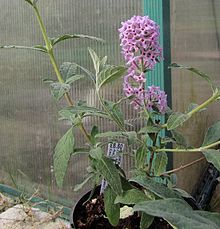Buddleja caryopteridifolia
| Buddleja caryopteridifolia | |
|---|---|
 |
|
| B. caryopteridifolia inflorescence. | |
| Scientific classification | |
| Kingdom: | Plantae |
| (unranked): | Angiosperms |
| (unranked): | Eudicots |
| (unranked): | Asterids |
| Order: | Lamiales |
| Family: | Buddlejaceae |
| Genus: | Buddleja |
| Species: | B. caryopteridifolia |
| Binomial name | |
|
Buddleja caryopteridifolia W. W. Sm. |
|
| Synonyms | |
|
|
Buddleja caryopteridifolia W.W.Sm. is a small deciduous shrub discovered by George Forrest in 1913 on open ground at 3,000 m on the Tong Shan in the Yangtze valley, China. The species was described and named by William Wright Smith in 1914.
Resembling B. crispa, it was sunk under this name by Leeuwenberg, although it remains recognized as a separate species in horticulture. It is likely that some specimens previously grown under this name at the Royal Botanic Gardens Edinburgh were actually Buddleja sterniana.
B. caryopteridifolia grows to 2 m in height in the wild, and bears small upright terminal panicles with relatively few flowers. The colour of the sweetly scented flowers is generally pink-purple, which appear in spring or late summer. The grey-green lanceolate leaves are less tomentose than B. crispa, usually with irregular toothed margins, although the margins of the commonly cultivated form are entire. Most leaves are opposite but occasionally shoots are produced with some alternate leaves. The foliage resembles that of several species of the Caryopteris genus for which it is named.
B. caryopteridifolia is fairly hardy in the UK, but loses all its leaves in winter. Relatively common in cultivation in the UK, specimens are grown as part of the NCCPG national collections at The Lavender Garden and The Longstock Nursery. The origin of the cultivated form is unknown. Hardiness: USDA zones 8–9.
...
Wikipedia
